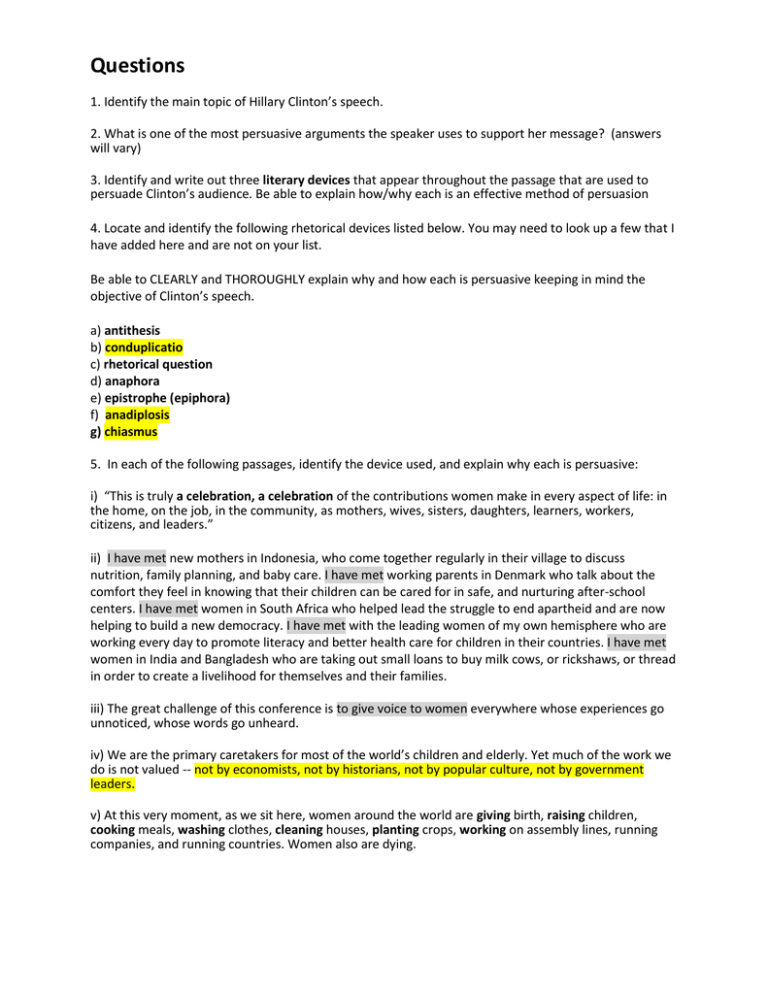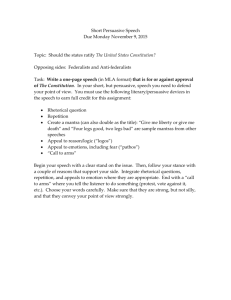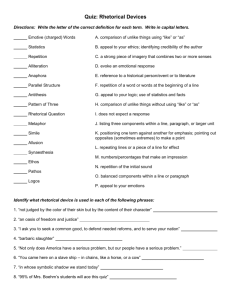Questions
advertisement

Questions 1. Identify the main topic of Hillary Clinton’s speech. 2. What is one of the most persuasive arguments the speaker uses to support her message? (answers will vary) 3. Identify and write out three literary devices that appear throughout the passage that are used to persuade Clinton’s audience. Be able to explain how/why each is an effective method of persuasion 4. Locate and identify the following rhetorical devices listed below. You may need to look up a few that I have added here and are not on your list. Be able to CLEARLY and THOROUGHLY explain why and how each is persuasive keeping in mind the objective of Clinton’s speech. a) antithesis b) conduplicatio c) rhetorical question d) anaphora e) epistrophe (epiphora) f) anadiplosis g) chiasmus 5. In each of the following passages, identify the device used, and explain why each is persuasive: i) “This is truly a celebration, a celebration of the contributions women make in every aspect of life: in the home, on the job, in the community, as mothers, wives, sisters, daughters, learners, workers, citizens, and leaders.” ii) I have met new mothers in Indonesia, who come together regularly in their village to discuss nutrition, family planning, and baby care. I have met working parents in Denmark who talk about the comfort they feel in knowing that their children can be cared for in safe, and nurturing after-school centers. I have met women in South Africa who helped lead the struggle to end apartheid and are now helping to build a new democracy. I have met with the leading women of my own hemisphere who are working every day to promote literacy and better health care for children in their countries. I have met women in India and Bangladesh who are taking out small loans to buy milk cows, or rickshaws, or thread in order to create a livelihood for themselves and their families. iii) The great challenge of this conference is to give voice to women everywhere whose experiences go unnoticed, whose words go unheard. iv) We are the primary caretakers for most of the world’s children and elderly. Yet much of the work we do is not valued -- not by economists, not by historians, not by popular culture, not by government leaders. v) At this very moment, as we sit here, women around the world are giving birth, raising children, cooking meals, washing clothes, cleaning houses, planting crops, working on assembly lines, running companies, and running countries. Women also are dying. vi) Speaking to you today, I speak for them, just as each of us speaks for women around the world who are denied the chance to go to school, or see a doctor, or own property, or have a say about the direction of their lives, simply because they are women. . vii) No one -- No one should be forced to remain silent for fear of religious or political persecution, arrest, abuse, or torture. viii) Tragically, women are most often the ones whose human rights are violated. If there is one message that echoes forth from this conference, let it be that human rights are women’s rights and women’s rights are human rights once and for all. Let us not forget that among those rights are the right to speak freely -- and the right to be heard. Final Thoughts – Note Literary devices create patterns in language: it arranges the words into nothing like ordinary speech. It is not only stylistically appealing but it also helps convey messages in a beautiful, powerful, more engaging and notable way. Rhetorical Devices (mainly repetition in its various formats) cannot be achieved through any other device. It has the ability of making a simple sentence sound like a dramatic one. It enhances the beauty of a sentence and stresses the point of main significance. Repetition often uses word associations to express the ideas and emotions in an indirect manner. The beauty of reading a text with repetition in it is the balance where we, as readers, have to decipher such associations and understand the underlying meanings. Repetition as you have seen can be used constructively: it lends emphasis on a point, confirms a fact or an idea, adds cohesion, provides transition, shows the importance of a subject: with bias or impartiality or describes a notion.








